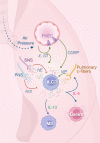Innate lymphoid cells: More than just immune cells
- PMID: 36389661
- PMCID: PMC9643152
- DOI: 10.3389/fimmu.2022.1033904
Innate lymphoid cells: More than just immune cells
Abstract
Since their discovery, innate lymphoid cells (ILCs) have been described as the innate counterpart of the T cells. Indeed, ILCs and T cells share many features including their common progenitors, transcriptional regulation, and effector cytokine secretion. Several studies have shown complementary and redundant roles for ILCs and T cells, leaving open questions regarding why these cells would have been evolutionarily conserved. It has become apparent in the last decade that ILCs, and rare immune cells more generally, that reside in non-lymphoid tissue have non-canonical functions for immune cells that contribute to tissue homeostasis and function. Viewed through this lens, ILCs would not be just the innate counterpart of T cells, but instead act as a link between sensory cells that monitor any changes in the environment that are not necessarily pathogenic and instruct effector cells that act to maintain body homeostasis. As these non-canonical functions of immune cells are operating in absence of pathogenic signals, it opens great avenues of research for immunologists that they now need to identify the physiological cues that regulate these cells and how the process confers a finer level of control and a greater flexibility that enables the organism to adapt to changing environmental conditions. In the review, we highlight how ILCs participate in the physiologic function of the tissue in which they reside and how physiological cues, in particular neural inputs control their homeostatic activity.
Keywords: IL-22; ILC1; ILC2; ILC3; gut homeostasis; metabolic homeostasis; neuroimmune interaction; physiological sensors.
Copyright © 2022 Xiong, Nutt and Seillet.
Conflict of interest statement
The authors declare that the research was conducted in the absence of any commercial or financial relationships that could be construed as a potential conflict of interest.
Figures



References
Publication types
MeSH terms
LinkOut - more resources
Full Text Sources
Research Materials

